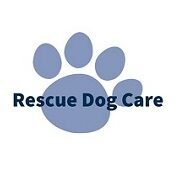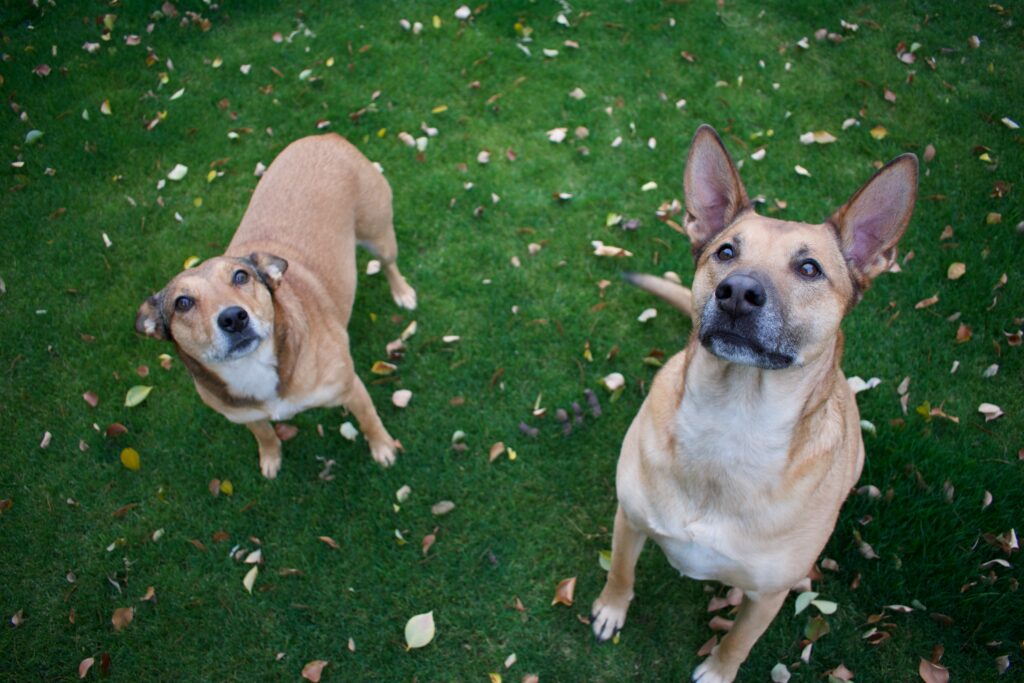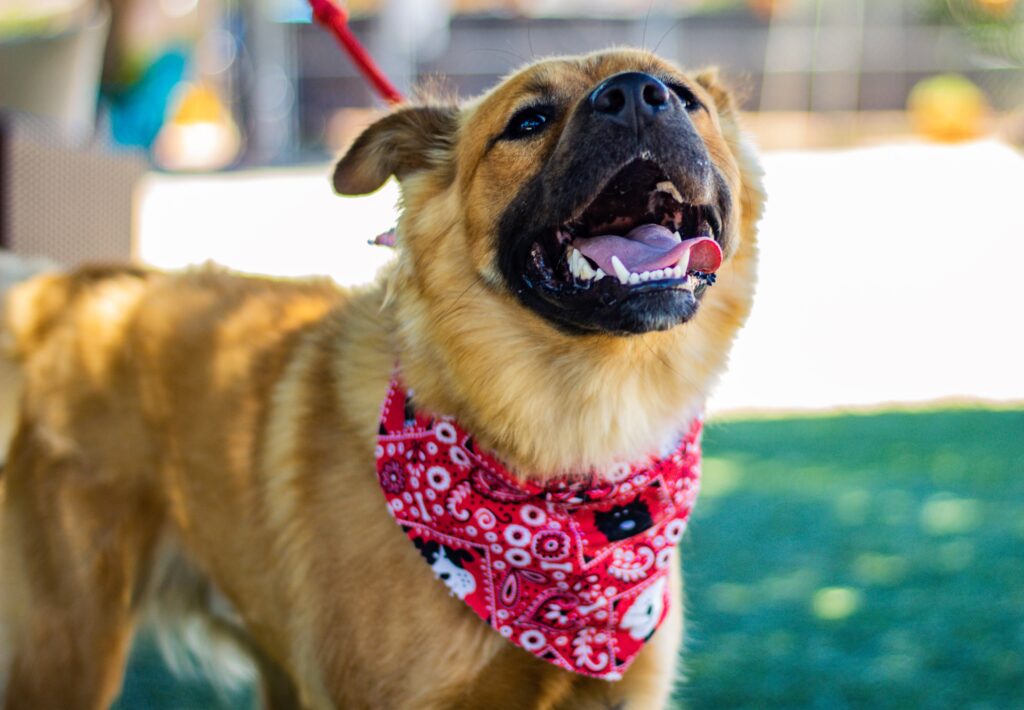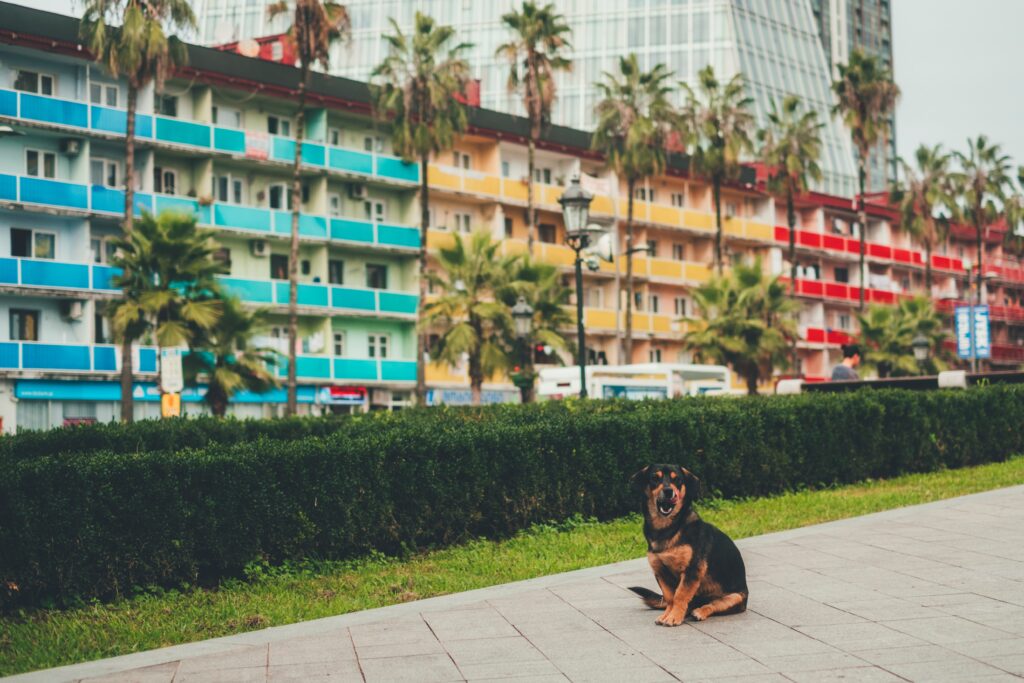For successful integration into your family and the well-being of your new furry companion, learning how to socialize a rescue dog is essential. In this blog post, we will dive into various aspects of socializing your rescue dog that are important for helping to overcome past bad experiences while building trust with people and dogs they meet on the street.
We’ll explore techniques such as loose lead introductions, reading canine body language, and gradual exposure methods to help your rescue dog become more comfortable around other dogs. Additionally, we’ll discuss different types of enrichment activities designed to boost confidence in these often-neglected pets.
Additionally we will cover how to set achievable goals during the socialization process while accepting limitations in some cases is vital. We’ll also cover equipment essentials like harnesses, leashes, and muzzles necessary for safe interactions between dogs.
Lastly, positive reinforcement techniques such as treats-based rewards and praise-based encouragement will be discussed as an effective means of promoting good behavior during the journey towards turning your rescue dog into a confident social butterfly.
Table of Contents
Understanding Rescue Dog Socialization
Socializing a rescue pooch is essential for their welfare and aptitude to adjust to new conditions. Adult rescue dogs often have preconceived notions about what’s going on around them due to past experiences or lack of exposure, making it essential for you as the owner to reward their bravery by showing them love, comfort, exercise, and positive interactions with other animals.
When we give advice to other individuals who are looking to adopt, having patience and putting yourself in the dogs paws (sort of speak) is of absolute importance.
Importance of Socialization in a Rescue Dog’s Life
Proper socialization helps your rescue dog become more comfortable in various situations and reduces anxiety caused by unfamiliar people or animals. A well-socialized pup will display good behavior when meeting new friends at the dog park, reducing the risk of aggressive encounters.
Additionally, proper socialization can decrease fear-based behaviors like excessive barking or hiding from strangers.
Overcoming Past Experiences and Building Trust
- Patient approach: Be patient with your new furry family member during this process since they may require extra time to overcome any negative associations from their previous lives.
- Create positive associations: Introduce new experiences gradually while providing treats or praise whenever they exhibit curiosity or interest in these situations. This helps build trust between you two.
- Educate yourself on dogs body language: Understanding your dog’s body language will help you identify signs of stress so that you can intervene before things escalate further – for instance, if your rescue dog is displaying dog body language that indicates fear or anxiety.
- Be aware of your own body language: Your dog can and will feed off your positive or negative body language.
- Seek professional help: If you’re struggling to make progress with socializing your rescue dog, consider consulting a certified animal behaviorist or trainer who specializes in working with dogs from shelters and rescues. They can provide valuable insights and guidance tailored specifically for your pup’s needs.
Acclimating a rescued pup can be highly gratifying, yet it is essential to comprehend the obstacles that accompany rescuing an animal and how best to tackle socialization.
With this in mind, introducing your rescue dog to other dogs requires special attention as well as knowledge of canine body language and loose lead introductions.
Introducing Your Rescue Dog to Other Dogs
Introducing your rescue pup to other pooches is a must for forming beneficial habits and social aptitudes. When introducing your rescue dog to another dog, it’s essential to keep the leash loose and avoid letting the dogs rush up to each other. This helps prevent any potential conflicts or increase fear between the animals.
Tightening the leash will give off a tense negative vibe and your furry friend will feed off this energy.
Loose Lead Introductions
To ensure a successful introduction, start by keeping both dogs on loose leashes. This allows them enough freedom of movement while still giving you control over their actions if needed.
Begin by walking both dogs parallel to each other at a safe distance apart, gradually decreasing that distance as they become more comfortable with one another. Remember always to reward positive interactions with treats and praise.
Reading Canine Body Language
Becoming familiar with dog’s body language is vital when introducing your rescue dog to new canine friends. Pay close attention during these initial meetings for signs of stress or aggression from either animal – such as raised hackles, stiff posture, growling, or bared teeth – which may indicate that it’s time for a break before trying again later.
If negative reactions persist between specific dogs at home or in public settings like parks or classes, consider seeking professional help from an experienced trainer who can guide you through proper socialization techniques tailored specifically for adult rescue dogs.
In some cases where introductions don’t go smoothly despite following all precautions mentioned above – house your pet only with those they feel comfortable around until further progress can be made in their socialization journey. This will help ensure a positive experience for both your rescue dog and the other dogs they encounter, ultimately turning them into a confident and well-adjusted social butterfly.
Introducing your rescue dog to other dogs is an important part of socialization, and by being aware of canine body language you can ensure a successful introduction. Building confidence through enrichment activities will help further the progress in socializing your rescue dog with others.
Key Takeaway: To socialize a rescue dog with other dogs, it’s important to keep the leads loose and watch for signs of stress or aggression. Gradually decrease the distance between dogs while making sure to reward positive interactions with treats and praise, but seek professional help if negative reactions persist.
Building Confidence Through Social Activities
Support your rescue dog’s proper social behavior through social activities that build confidence gradually over time. Start small by training exercises within familiar spaces such as backyards before venturing out into more challenging environments once trust has been established between both parties involved (owner & animal).
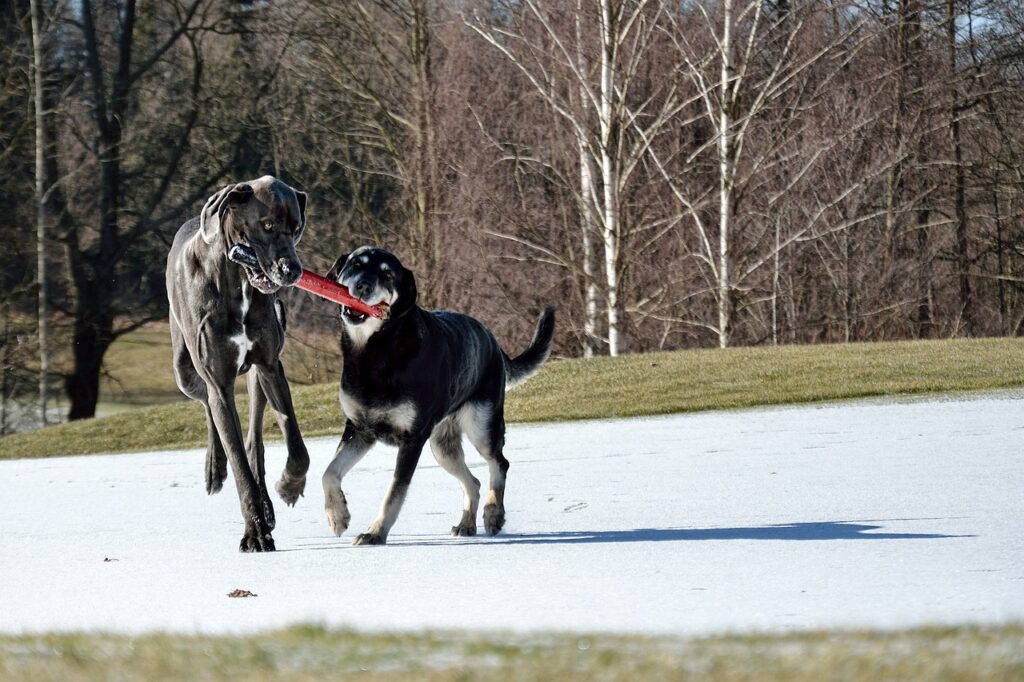
Gradual Exposure Techniques
To help your rescue dog develop their social skills, begin with gradual exposure techniques. Introduce them to new experiences and stimuli in a controlled manner, allowing them to explore at their own pace.
For example, you can start by taking short walks around the neighborhood or inviting one well-behaved adult dog for a playdate in your backyard. It really helps to have a close family member or friend that also has a dog to help your furry rescue acclimate.
- Keep initial interactions brief and positive.
- Increase the duration of encounters as your dog becomes more comfortable.
- Avoid overwhelming situations that may increase fear or anxiety in your rescue dog.
Types of Enrichment Activities
Enrichment activities are designed to stimulate a dog’s mind and body while promoting good behavior. These activities can range from simple games like fetch or tug-of-war to advanced obedience training sessions. Some popular options include:
- Puzzle toys: Engage your pet’s problem-solving abilities with interactive puzzle toys that dispense treats when solved correctly.
- Scent work: Hide treats or scented objects around the house for your canine companion to sniff out and locate.
- Agility training: Set up a small agility course in your backyard to challenge your dog’s physical and mental capabilities.
Incorporating these activities into your pup’s everyday regimen can help them build assurance and more quickly adjust to new environments, making the socialization process easier for both of you. This will ultimately make the socialization process smoother for both you and your furry friend.
Building confidence through enrichment activities is a powerful tool for socializing rescue dogs, as it allows them to explore and discover their environment in a safe and comfortable way. By managing expectations during the socialization process, we can ensure that our goals are achievable while also accepting any limitations of the situation.
Managing Expectations During Socialization Process
It is important to not only physically but also mentally prepare yourself as an owner by having realistic expectations regarding how quickly progress might be made – preventing frustration towards your furry friend who needs patience above all else. Some rescue dogs may never learn to love certain social situations, but can still be taught tolerance.
In this section, we will discuss setting achievable goals for socialization and accepting limitations in some cases.
Setting Achievable Goals for Socialization
To ensure a smooth process of socializing your rescue dog, it’s essential to set attainable milestones that cater to their unique needs and background. Start with small steps such as introducing them to one new person or animal at a time before gradually increasing the complexity of their interactions. Observe your dog’s body language closely during these encounters, and adjust the pace accordingly if you notice any signs of increased fear or discomfort. Realize that each pup has its own individual characteristics; some may take more time than others to gain the appropriate social skills.
Accepting Limitations in Some Cases
In certain instances, it’s crucial for pet owners to accept that their rescue dogs might have limitations when it comes to interacting with other animals or people due to past experiences or trauma. Rather than pushing them into unfamiliar circumstances, focus on fostering trust and making them feel safe in their new surroundings. If necessary, consult with a professional trainer or behaviorist who specializes in working with rescue dogs so they can provide guidance tailored specifically for your canine companion.
By managing your expectations and understanding that every rescue dog’s journey to becoming a social butterfly is unique, you can create a positive environment for them to learn good behavior and adapt successfully to their new life.
Managing expectations during the socialization process is essential for a successful experience. To ensure the socialization process is successful, it’s important to have the necessary equipment ready.
Key Takeaway:
When socializing a rescue dog, it’s important to manage your expectations and set achievable goals. Every dog is different, so start with small steps and adjust the pace according to their body language. Accept that some dogs may have limitations due to past experiences or trauma and focus on building trust instead of forcing them into uncomfortable situations.
Equipment Essentials for Successful Socialization
Being equipped properly will help you in socializing your rescue dog. Opt for a snug-fitting harness and short leash that allows you better control over their movements if things get too intense during an interaction with another animal or person. For reactive, aggressive, or fearful pups, investing money, time, and effort into acquiring a muzzle could prove beneficial.
Harnesses and Leashes
A properly fitted harness can provide more comfort and security than a traditional collar when it comes to managing your rescue dog’s body language during socialization sessions. A harness works best on smaller dogs 50 pounds or under.
If your dog tends to pull a harness is not the best approach. A leash of moderate length (4-6 ft) is suggested to provide better management while allowing the pup some range of motion.
Avoid using retractable leashes as they may increase fear due to the constant tension on the lead.
Muzzles for Safety
If your rescue dog exhibits signs of aggression or extreme fear towards other dogs or people, consider using a muzzle during socialization exercises. This safety measure not only protects others but also gives both you and your pet peace of mind while working through proper socialization techniques. Ensure that the muzzle fits comfortably without causing any discomfort to your pup – this might require trying out different types before finding one that suits them best.
- Tip: Gradually introduce the muzzle by associating it with positive experiences such as treats and praise so that wearing it becomes less stressful for your furry friend.
- Very Important: Muzzles should not be used on long walks especially when it is hot. Dogs pant and hold their mouths open to cool themselves. A muzzle makes this more difficult and a dog could overheat.
- Note: Muzzles should not be used as a long-term solution but rather as a temporary aid during the socialization process.
Remember, patience and consistency are key when working with rescue dogs. By utilizing the correct tools and abiding by appropriate socialization practices, you can help your pup become more relaxed in a range of scenarios and evolve into an integrated part of your household.
Having the right equipment for successful socialization is essential, so be sure to invest in a quality harness and leash as well as a muzzle for safety. Next, we will discuss positive reinforcement techniques that can help you successfully socialize your rescue dog.
Key Takeaway:
To socialize a rescue dog, it is important to have the right equipment such as a snug-fitting harness and short leash. For reactive or aggressive dogs, investing in a muzzle can be beneficial for safety during socialization exercises. Gradually introducing the muzzle with positive experiences can help your furry friend become more comfortable and well-adjusted in various situations.
Positive Reinforcement Techniques
When it comes to training your rescue dog, never resort to yelling or punishing misbehavior. Instead, opt for positive reinforcement through treats and gentle praise, which will ensure optimal results achieved across all areas involved, including owner-animal bond strengthening. This section discusses the importance of using positive reinforcement techniques in socializing a rescue dog and offers some practical tips on how to implement them effectively.
Treats as Rewards
One effective way of reinforcing good behavior in your rescue dog is by offering treats as rewards. When your dog exhibits desirable social skills, such as calmly approaching another animal or person, immediately reward them with a small treat. This helps create an association between their good behavior and receiving something enjoyable. Be sure to choose healthy treats that are appropriate for your pet’s size and dietary needs.
- Tip: Keep a variety of treats handy during socialization sessions so you can switch things up if needed.
- Note: Do not overfeed your pet with treats; they should only make up around 10% of their daily calorie intake.
Praise-based Encouragement
In addition to providing tasty incentives, verbal praise plays an essential role in building confidence within adult dogs who may have experienced trauma or neglect earlier on in life. Whenever possible throughout each interaction involving other animals or people, offer words like “good job” accompanied by gentle pats on the head area when applicable. This not only reinforces positive actions but also helps establish trust between both parties involved (owner and animal).
Remember, patience and consistency are key when socializing a rescue dog. By applying consistent, patient methods of reinforcement, you can assist your canine companion in developing into a content and balanced member of the home.
Key Takeaway:
To socialize a rescue dog, positive reinforcement techniques such as offering treats and verbal praise are crucial. Using healthy treats as rewards for good behavior helps create an association between desirable actions and receiving something enjoyable, while verbal encouragement builds confidence and trust between the owner and animal.
FAQs in Relation to How to Socialize a Rescue Dog
How to Socialize a Rescue Dog
If you’ve recently adopted a rescue dog, you may be wondering how to help them adjust to their new home and surroundings. Proper socialization is key to helping your rescue dog develop good behavior and social skills. Here are some tips to get started:
Gradual Exposure
Start by gradually exposing your rescue dog to new environments and experiences. This can include walks in different neighborhoods, visits to the dog park, and meeting new people and animals. Use positive reinforcement techniques like treats and praise-based encouragement to reward good behavior.
Canine Body Language
When introducing your rescue dog to other dogs, pay attention to their body language for signs of stress or discomfort. Keep them on a loose lead and allow them to approach other dogs at their own pace. If they show signs of fear or aggression, remove them from the situation and try again later.
Enrichment Activities
Enrichment activities like puzzle toys and training exercises can help build your rescue dog’s confidence and mental stimulation. This can also help increase their social skills and make them more comfortable in new situations.
The 3-3-3 Rule
The 3-3-3 rule refers to the stages of adjustment that many rescue dogs experience after adoption. It takes three days for initial decompression, three weeks for settling into routines, and three months for feeling secure in their new home. This guideline helps adopters manage expectations during the transition period.
Building a Relationship
A strong bond with your rescue dog can be built through consistency in routine, training using positive reinforcement methods, providing mental stimulation via enrichment activities, offering affection when appropriate, and respecting their boundaries at all times. Building trust takes time but will ultimately result in a rewarding partnership between you both.
Conclusion
Rescue dogs oftentimes have a past of suffering and disregard, making the process of acclimation an essential element in their recuperation. By gradually exposing them to new experiences and using positive reinforcement techniques, you can help your rescue dog build confidence and trust.
Introducing your rescue dog to other dogs through loose lead introductions and reading canine body language is also important for their socialization journey. It has been our experience that socializing your rescue works best when you are able to have a close friend or family member help adjust your dog to theirs.
A close friend or family member are likely to be more patient during the socialization process. It’s essential to manage expectations during the process by setting achievable goals while accepting limitations in some cases.
If you’re looking for more information on how to socialize a rescue dog, visit rescuedogcare.com. Their resources can help guide you through the process of rehabilitating your furry friend into becoming a well-adjusted member of society.
